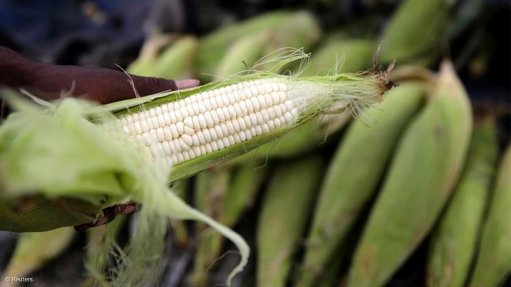
Photo by: Reuters
While South Africa’s maize production will be about 2.1-million tons lower this year, there is still enough to meet local consumption and supply neighbouring countries that are having difficult growing seasons owing to adverse weather, financial services firm Standard Bank says.
According to the Crop Estimates Committee (CEC), South Africa is projected to produce 14.3-million tons of maize this year, compared with 16.4-million tons produced last year, which was also the second-highest crop on record.
With domestic consumption of maize averaging below 12-million tons every year, Standard Bank environment, social and governance and climate change investment analyst Dr Penny Byrne says the country should have enough maize to cover local demand and some demand from abroad, including from neighbouring countries such as Zambia, Botswana and Zimbabwe.
She adds that these countries have experienced trying conditions associated with El Niño, with an exceptionally dry February. Much of Southern Africa has experienced extreme heat this season, Byrne points out.
Zambia has declared a national disaster as the country battles with drought conditions, which has negatively impacted on its summer crops, copper production and energy production.
The country generates about 87% of its electricity from hydropower – but the Zambezi River Authority has reduced its allocation of water for electricity generation to Zambia and Zimbabwe to 16-billion cubic litres in 2024, down from 30-billion cubic litres in 2023 and 40-billion cubic litres in 2022.
Zambia now has to contend with as many as eight hours of loadshedding daily as the drought impacts on power generation. Almost half of the maize crop has been lost, and maize prices have rocketed in recent months.
Meanwhile, Standard Bank initially expected that South Africa would have another bumper summer crop, since rainfall had been average across most of the top-growing regions in the country in the early part of the season; however, a flash drought in February set in during a crucial time in the growth cycle of summer crops.
These conditions have been exacerbated across the western part of the maize belt, which has resulted in a spike in South African Futures Exchange white maize prices.
“Still, the last three summers resulted in bumper crops in South Africa largely due to the impact of La Niña, which brought good rainfall over the country. This means solid carry-over stocks to buffer a potentially poor harvest this year. Nevertheless, higher white maize prices might still impel higher food inflation this year,” Byrne explains.
She concludes that the global grains market is in good shape, fortunately, with record global production across many grains resulting in lower prices internationally.
Additionally, the current El Niño-Southern Oscillation forecasts suggest a high likelihood that it will end in coming months, with the more wet La Niña resurging for the 2024/25 summer season.